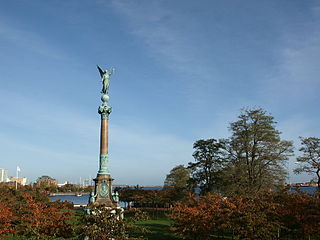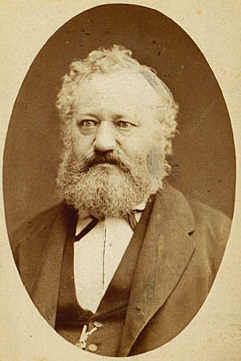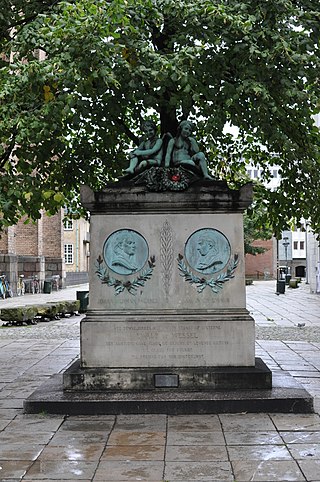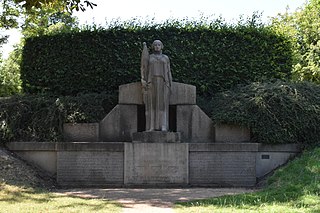
The Battle of Heligoland was fought on 9 May 1864, during the Second Schleswig War, between a Danish squadron led by Commodore Edouard Suenson and a joint Austro-Prussian squadron commanded by the Austrian Commodore Wilhelm von Tegetthoff. The action came about as a result of the Danish blockade of German ports in the North Sea; the Austrians had sent two steam frigates, SMS Schwarzenberg and Radetzky, to reinforce the small Prussian Navy to help break the blockade. After arriving in the North Sea, Tegetthoff joined a Prussian aviso and a pair of gunboats. To oppose him, Suenson had available the steam frigates Niels Juel and Jylland and the corvette Hejmdal.

The Isted Lion is a Danish war monument originally intended as a monument of the Danish victory over German-minded Schleswig-Holstein insurgents in the Battle of Isted (Idstedt) on 25 July 1850, during the First Schleswig War which was a civil war within the Danish Realm, although with troops from Prussia supporting the Schleswig-Holstein insurgents. At its time it was the largest battle in Scandinavian history.

Nyboder is a historic row house district of former Naval barracks in Copenhagen, Denmark. It was planned and first built by Christian IV to accommodate a need for housing for the personnel of the rapidly growing Royal Danish Navy and their families during that time. While the area is still commonly associated with the name of its founder as one of his numerous building projects around Copenhagen, the Nyboder seen today was in fact, except for a single row of houses in Sankt Pauls Gade, built from 1757.

The Ivar Huitfeldt Column is a monument at Langelinie in Copenhagen, Denmark, built to commemorate the death of Admiral Ivar Huitfeldt and his men from HDMS Dannebroge, which exploded and sank in the Battle of Køge Bat during the Great Northern War. The monument was constructed in 1886 to a design by Vilhelm Dahlerup. Ferdinand Edvard Ring was responsible for the statue of the Roman goddess of victory, Victoria, and for the reliefs, while Carl Brummer undertook the monument's architectural design.

Store Kongensgade is the longest street in central Copenhagen, Denmark. It extends northeast from Kongens Nytorv to Esplanaden, running parallel to Bredgade, where it breaks left, continuing northwest to Grønningen.

An equestrian statue of Christian IX stands on the market place in the centre of Esbjerg, Denmark. Designed in bronze by Ludvig Brandstrup, it was completed in 1899.

Monuments in the Basilica of Santa Maria del Popolo are tombs and funerary monuments ranging from the 15th to the 19th centuries. Since its rebuilding in the 1470s by Pope Sixtus IV the Basilica of Santa Maria del Popolo was one of the favourite burial places for members of the papal aristocracy, clergy and literati. Foreign artists were also buried in the church due to its location near their favourite quarter in Rione Campo Marzio. The high number of tombs and monuments makes the basilica a whole museum of sculpture as Jacob Burckhardt phrased it in his famous guide of Italian art in 1855. Besides the tombs in the side chapels and the choir there are many other funeral monuments in the aisles and the transept. During the centuries several monuments were demolished and others were relocated to give place to newer ones.

The London Troops War Memorial, located in front of the Royal Exchange in the City of London, commemorates the men of London who fought in World War I and World War II.

The equestrian statue of Absalon on Højbro Plads in Copenhagen was unveiled in 1902 to mark the 700 years' anniversary of the death of Bishop Absalon, the city's legendary founder.
Water Art is a sculpture by Danish artist Anders Tinsbo that is on permanent display near Rundetårn in Copenhagen.

The Statue of Niels Juel, created by the sculptor Theobald Stein, was unveiled in 1881 at Holmens Kanal in Copenhagen, Denmark. It stands next to Church of Holmen where he is buried and close to his former home in Kongens Nytorv. The monument with surroundings was listed in 2004.

Christianshavns Enveloppe is a former system of outworks located in front of Christianshavns Vold and Stadsgraven, on Amager. in Copenhagen, Denmark. Its well-preserved, northern half is now part of Freetown Christiania and known as Dyssen. Its southern portion was removed in the first half of the 20th century and has now been replaced by a public park, Enveloppeparken.

Lauritz Godtfred Rasmussen was a Danish zinc and bronze caster. He established a zinc and bronze foundry in his own name in Copenhagen in 1865 and was appointed royal court caster in 1883. Many Danish monuments from the second half of the 19th century come from his foundry. It was later taken over by his son Carl Rasmussen and remained in the family for several generations.

The Johannes Ewald and Johan Hermann Wessel Memorial is located next to the Round Tower and Trinitatis Church, just off Købmagergade, in central Copenhagen, Denmark. Johannes Ewald and Johan Herman Wessel were two of the leading Danish poets of the 18th century.

The Reunification Monument marks the main entrance to Fælled Park from Trianglen in the Østerbro district of Copenhagen, Denmark. It was created by the artist Axel Poulsen, in collaboration with the architect Holger Jacobsen, to commemorate the reunification of Sønderjylland with Denmark in 1920.

The Memorial to Nordic Volunteers and Fallen, located on Smedelinien, part of Kastellet, is a memorial to 28 Norwegian, Swedish and Finnish volunteers of the First (1848–50) and Second Schleswig War (1864). It was inaugurated in 1920 to design by Anders Bundgaard.

Østbirk Church is a parish church in Horsens Municipality. It is overseen by the Diocese of Aarhus in the Church of Denmark.

The Collingwood Monument is a Grade II* listed monument in Tynemouth, England, dedicated to Vice Admiral Lord Cuthbert Collingwood. A Napoleonic-era admiral noted for being second-in-command to Admiral Lord Nelson during the Battle of Trafalgar, Collingwood is sometimes referred to as the forgotten hero of Trafalgar. The monument's base is by John Dobson and the statue is a work of the sculptor John Graham Lough. It is situated just off Front Street in Tynemouth and overlooks the mouth of the River Tyne.

Edouard Suenson (1805-1887) was a Danish vice admiral known for his participation in the First and Second Schleswig War, and served as the main Danish commander at the Battle of Heligoland in the latter.

The Statue of Asmus Jacob Carstens is a statue of German-Danish painter Asmus Jacob Carstens situated in the garden of the Ny Carlsberg Glyptotek, facing Niels Brocks Gade, in Copenhagen, Denmark. It was created by Theobald Stein in 1878–1879 and moved to its current location in 1894. It is complemented by a statue of Georg Zoëga facing Tietgensgade on the other side of the museum. The monument is flanked by two other bronze statues, Jules Dalou's Field Worker (1893) and Constantin Meunier's The Hammerman.





















